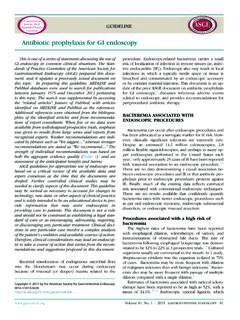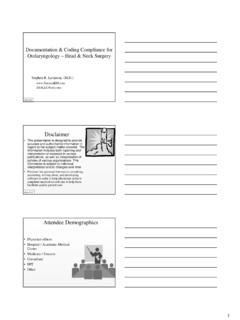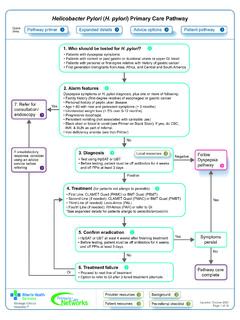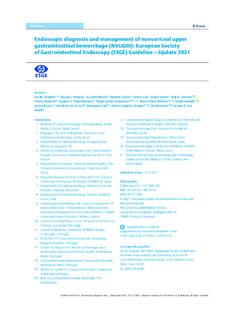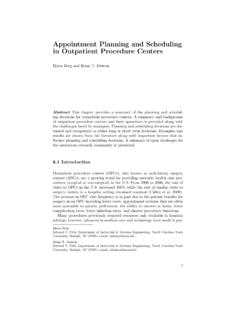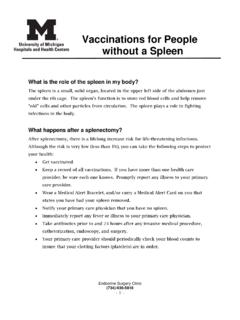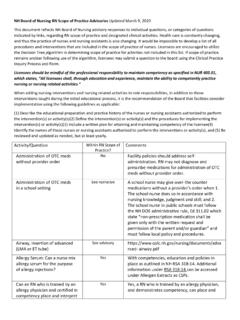Transcription of Going lean in the NHS
1 Going lean in the NHSG oing lean in the NHSHow lean thinkingwill enable the NHSto get more out of the same resourcesAn introductory guide for healthcare organisations seeking to: improve quality and efficiency improve patient care and experience improve safety and reduce mortality reduce length of stay reduce waste lower costs eliminate delays improve staff morale1 Lean thinkingfor better, safer healthcare with no delaysFive principles of lean to maximise customer value by eliminating waste ..5 Who is a customer? ..5 Principle 1: Specify 's valued / not valued by patients and carers?..6 Principle 2:Identify the value stream or patient stream mapping enables staff to see waste ..7 Designing a better way of working without waste and patients ..8 Action plan ..8 Make someone responsible for the whole patient journey ..8 Principle 3:Make the process and value A&E ..10 Value stream maps to help expose the waste.
2 10 Case study: Hereford Hospitals NHS Trust endoscopy unit ..11 Simple tools for better and safer working the lab before and after a 5 Sactivity ..13 Standardising processes and the steps within them ..14 Principle 4:Let the customer the whole patient journey to improve care ..16 Exploiting the pull rather than the push ..16 Principle 5:Pursue people recognise when things are Going wrong ..17 Overview of lean implementation and its study: Bolton Hospitals - Better quality plus waste reduction, in days not months ..18 Critical success 20 Case study: Rapid improvement event at Mayday Healthcare NHS Trust sterile services ..21If you're excited about the benefits of lean thinking, here are some points to thinking is increasingly being applied to health services in the UK and overseas to: improve the quality of patient care improve safety eliminate delays reduce length of staywhile using no more resourcesSome healthcare organisations in the UK are already obtaining real benefits by the adoption of this guide includes NHS case studies showing the principles and benefits thinking, developed from the ToyotaProduction System, has been applied inmany competitive sectors.
3 Tesco, forexample, is one of the biggest and mostsuccessful lean companies in the thinking identifies the least wasteful way to provide better,safer healthcare to your patients with no s about being able to do more with the resources principles of lean thinking enhance the quality of healthcareby improving flow in the patient journey and eliminating waste:1 Specify value2 Identify thevalue stream orpatient journey3 Make theprocess andvalue flow4 Let thecustomer pull 5 Pursueperfection4 Principles1 Specify valueThis can only be defined by the is any activity which improves the patient's health, well being and the value stream or patient journeyThis is the core set of actions required to deliver value for the process and value flowAlign healthcare processes to facilitate the smooth flow of patients and the customer pullThe customer should begin to pull products or services as should deliver care on demand, with the resources needed for perfectionDevelop and amend processes continuously in pursuit of the for healthcareIn healthcare we need to identify and agree what value we provideto that improves patient care and experience is addingvalue, anything else is waste, eg.
4 Less waiting and delay better outcomes fewer adverse incidentsWe also need to identify who our customers are. An obviouscustomer is the patient, however, other customers do exist andneed to be covers the whole patient journey from start to which steps add value and improve quality for the a patient this means: avoiding queuing and batching avoiding multiple referrals removal of all obstacles which prevent the quickest safestpractical flow of careWe need to create pull in the patient journey. Every step in thepatient journey needs to pull people, skills, materials and informationtowards it, one at a time, when means responding to demand, rather than handing off patientsand pushing them from one department or ward to example: A ward phoning for the next patient rather thanwaiting for the the patient this means completing their care and treatment with the best outcome with no mistakes on time without delayTo achieve this we need consistent and reliable processesHow to maximise customer value by eliminating as muchwaste as possible from patient care and NHS servicesWaste is anything other than the minimum amount of equipment, space, staff time, which are essentialto add value to the product or (Defects)
5 WaitingTransportationOverprocessingInven toryMotionOverproductionDescriptionRewor k due to faulty processesRepeating things because correct informationwas not provided in the first placePeople unable to process their workbecause they are waiting for people,equipment or informationMoving materials unnecessarilyPerforming unnecessary processing stepsthat do not add valueToo much work in progress or stockInformation or patients waiting in a queueUnnecessary people motions, travel,walking and searchingThings not within reachThings not easily accessibleProducing more than is needed, or earlierthan needed by the next processHealth service examples readmission because of failed discharge adverse drug reactions repeating tests because correct information was not provided waiting for: patients theatre staff results, prescriptions and medicines doctors to discharge patients staff walking to the other end of a ward to pick up notes central equipment stores for commonly used items insteadof items located where they are used duplication of information asking for patients details several times repeated clerking of patients excess stock in storerooms that is not being used patients waiting to be discharged waiting lists unnecessary staff movement looking for paperwork, eg drug sheets not put back in the correct place storing syringes and needles at opposite ends of the room not having basic equipment in every examination room requesting unnecessary tests from pathology keeping investigation slots 'just in case'We identify and eliminate these various kinds of waste by applyingthe five principles, as described on the following is a customer?
6 An obvious customer in healthcare is the patient. However, other customers exist. A customer issomeone who uses something that is made or provided by a previous process step. For example, a ward or the staff ona ward are customers of patients and information they receive from the Accident and Emergency a lean perspective there are seven types of waste:Principle 1:Specify valueFor exampleValued by patients and carersExperiencing no delaysHigh standards and good serviceNot catching infections while inhospitalBeing treated in the right place atthe right time by the right personNot valued by patients and carersHaving to waitHaving their time wastedProcesses which delay recovery, eg: missing a procedure becauselaboratory tests are not available rescheduled outpatient appointmentsbecause staff are on holidayThe first step is to specify valueto thepatient or their carer. Value is any activity which improves thepatient's health, well being and professionals need to spend time identifying: what patients value what they want from the NHSLean will help cut delays6 Identify thevalue stream orpatient journey2 Make theprocess andvalue flow3 Let thecustomer pull 4 Pursueperfection5 Specifyvalue17 Identifying the value streammeansidentifying the components of thepatient journey which add value totheir care.
7 One method of doing thisis value stream stream mappingenables staffto expose wastein their involved in the various steps alongthe patient journey get together to: map out how the process currently operates identify all the waste and delays, using dataPrinciple 2:Identify the value stream or patient journeyThe next step is to look at the second leanprinciple: identify the value stream. There aremany value streams involved in treating a will help to cut out wasteQuantifiable information and actualtimes are added to the value streammap. This helps staff understand howthe process operates. Value streammapping differs from process mappingin that it maps the flow of informationand patients and uses quantifiableinformation and measurement to build a picture of how the process currently processes are mappedin a visual way, thiswill expose duplicate steps unnecessary work lack of clear rolesand responsibilitiesFor more information on how to do this go to + then work together designing a better way of working withoutall the waste, duplication and thevalue stream orpatient journey2 Make theprocess andvalue flow3 Let thecustomer pull 4 Pursueperfection5 Specifyvalue1 Staff from preoperative assessment.
8 The Daycase unit and theatres designhow they want the process to operatewithout the waste and from the endoscopy unit at Hereford Hospital map theendoscopy process and validate their patients in this processensures the patient perspective ismaintained at all action plan with cleartimescalesis produced, with anominated lead made responsible for quickly implementing the benefits often resultwithout major resources beingrequired. Getting staff together andworking in partnership is often themost challenging someone responsible for the whole patient journeyIt is advisable to have someone in yourorganisation responsible for the wholepatient journey from start to need the authority to remove blockages keep patients and informationmovingThis role could be an extension of anexisting role rather than a new example, matrons could be usedto actively manage patient to common belief, demand on healthcareprocesses is mostly predictable within a range.
9 Often it isthe way the process is designed and operated that causesany example:The timing and numbers of emergencyadmissions are more predictable than elective causes resource bottlenecks and staff stress,and a poor patient will help cut length of stayPrinciple 3 Make the process and value flowAlign healthcare processes to facilitate thesmooth flow of patients and information. To do this we need to understand demandfor services and avoid batching and the type and frequency of demandWe need to recognise that all patients are different but can be grouped by theprocesses they require. Patients requiring the same skills and technology have a similarrate of processing (cycle time). They can be grouped together into a separate stream maps help expose the wasteValue stream maps usually disclose lots of batching and queuing, causing unevenflow through the process, excessive waste and delays. The aim is to make the batchsize (the number of patients or tests processed together) as small as exampleOne of the more effective improvements in A&E departments is toseparate the minor injuries from the major and resuscitation with minor conditionshave a huge variety and range ofconditions.
10 Yet all require a quick simple process to treat them experienced and competent staff minimal equipmentProcessing most patients in under 20 minutes improves the overall time inA&E for the vast majority of and resuscitation patientsare fewer in number, but requiredifferent skills and technology and have much longer cycle minors with majors is like putting a lorry into the fast lane on amotorway. It slows the speed of the whole exampleThink how a day surgery unit it be better to have all patients arriving when the unit opens in the morning? or a continuous flow of patients at regular intervalsA major benefit from achieving smooth flow is that the status of a processbecomes much more visible. It is therefore much easier to see when thingsare Going wrong and make corrections see case study on next thevalue stream orpatient journey2 Make theprocess andvalue flow3 Let thecustomer pull 4 Pursueperfection5 Specifyvalue1 endoscopy unit staff said they hadn t enough recovery trolleys to meet demand.










